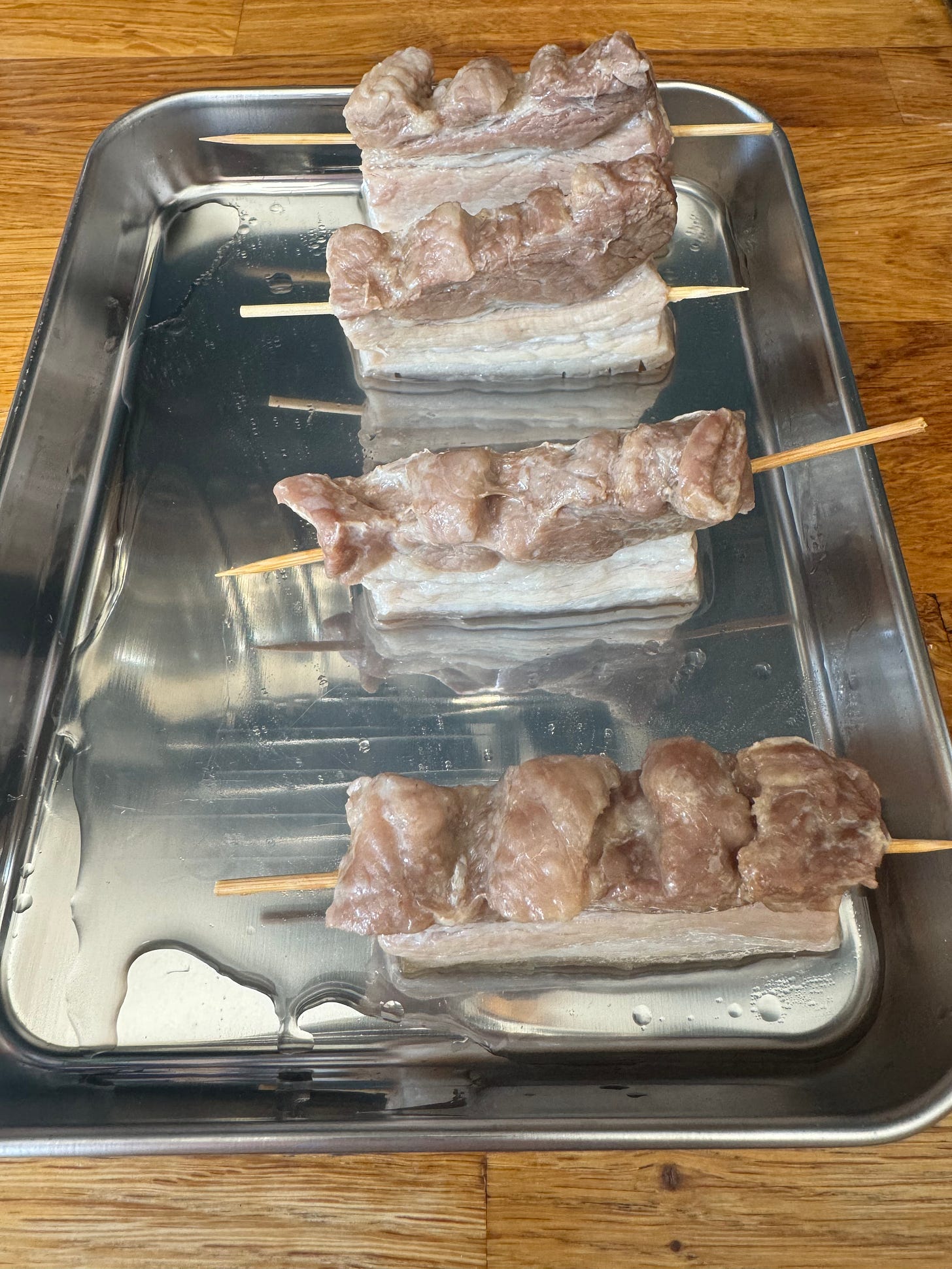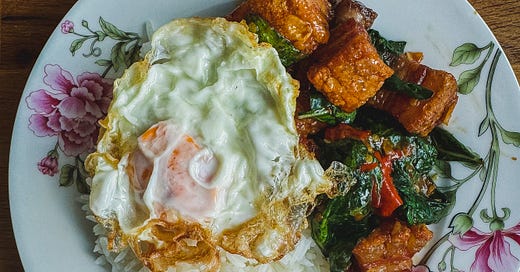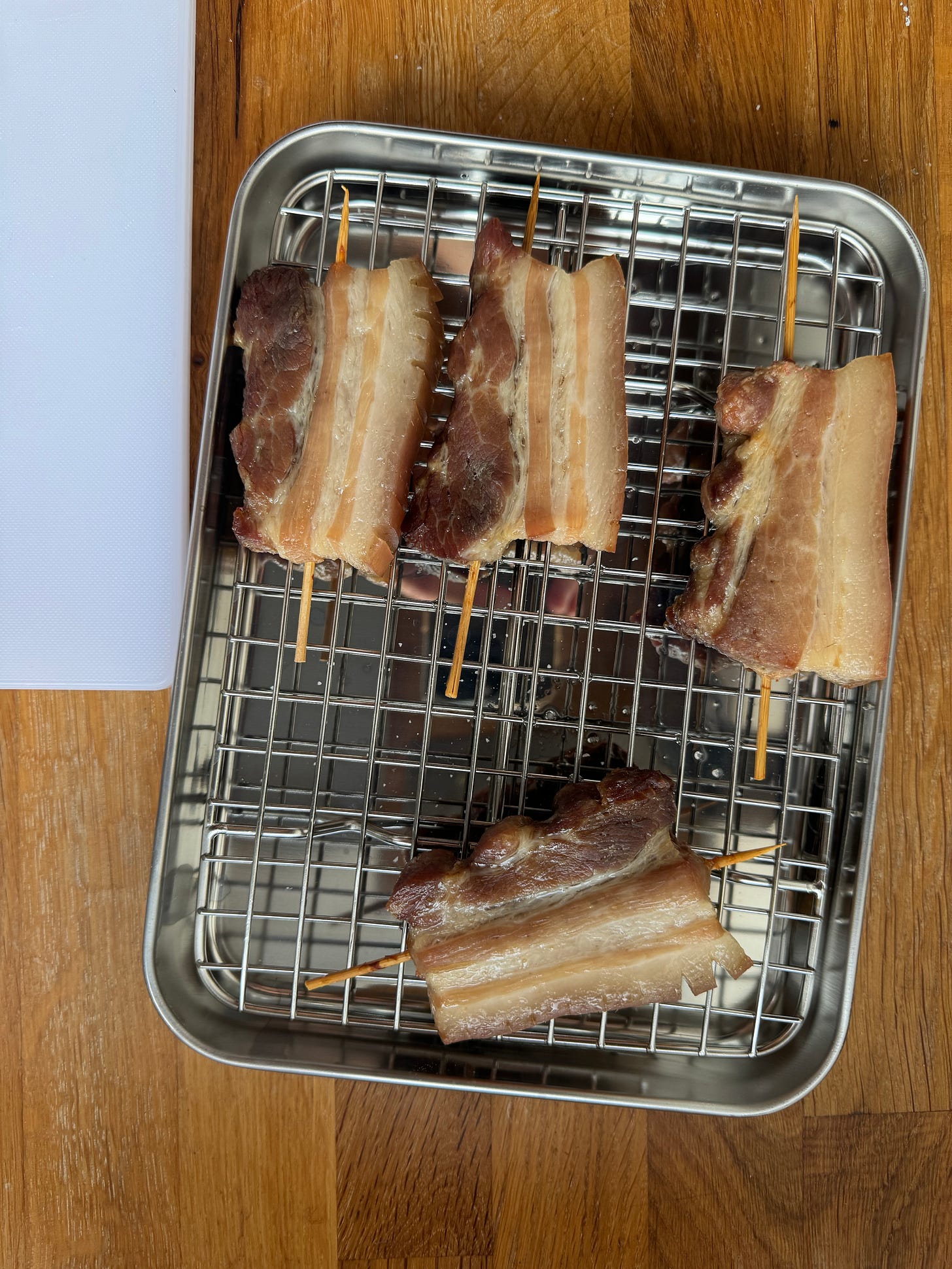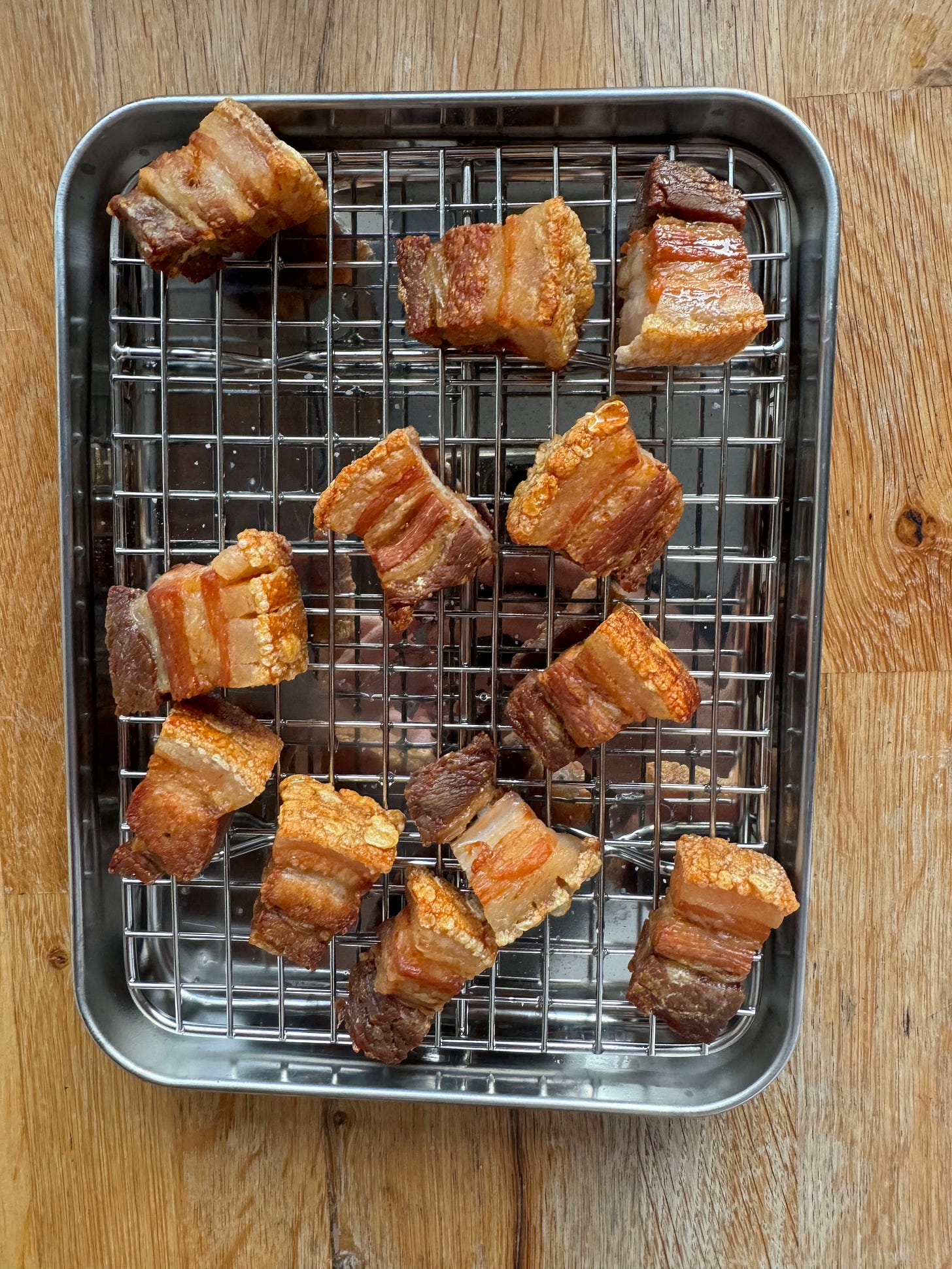Part II: Chilli Basil Stir-Fry
A dish called pad krapow muu krob, and a simple(r) way to cook it at home
The other month, I wrote a piece (and recipe) on the dish known in Thai as pad krapow, anglicised as ‘chilli basil stir-fry’ — a dish of holy basil stir-fried with garlic, chillies and meat. As I mentioned in that article, pad krapow and its more accessible cousin, pad horapa (Thai basil stir-fry), are world-renowned. For a good reason, too — they’re easy to make, contain mostly accessible ingredients and are irrefutably delicious.
Perhaps the most common preparation for this dish calls for minced meat - often pork or chicken. But another version, lying just outside the cusp of Western mainstream attention, exists; a dish known as pad krapow muu krob or simply crispy pork belly stir-fried with holy basil. It is an insanely delicious dish, combining the flavour-packed elements of pad krapow with one of the world’s most loved ingredients - fatty, crispy, succulent pork belly.
Muu krob
Muu krob is unfathomably tasty. A cross-cultural evolution of the Cantonese siu yuk brought to Bangkok my Chinese immigrants, muu krob is onerous to make requiring extended time for marination, par-cooking, drying, more-marination/curing, and frying or roasting. In the realm of Thai cuisine it appears in dishes like pad kana muu krob (Chinese broccoli stir-fried w/ crispy pork belly), guay jap (a soup of rolled rice noodles and crispy pork), pad krapow muu krob (duh), but is also often enjoyed by itself with jasmine rice.
The aversion to making pad krapow muu krob at home
I think this dish is so seldomly attempted by home cooks or featured on social media over here in the West because its preparation is incongruent with the ebbs and flows of home cooking. That is to say, it’s a process to make a muu krob in and of itself; if one is going to make a big slab of muu krob, it follows that he or she will make a large batch; crispy pork belly doesn’t keep well beyond serving; stir-frying at home is hard to do in large quantities; pad krapow by its very nature is a ‘one-plate’ meal - i.e. it is most commonly served as an individual meal as opposed to a sharing dish among a main meal.
For these reasons, I imagine that few people can be bothered to go through the time-consuming, intricate process of making muu krob just to use it in a stir-fry. In fact, if I think about the way I’ve seen/experienced muu krob in Thailand, it's often at vendors who specialise in the making of it, who make significant quantities and thus offer a variety of ways to eat it - i.e. by itself with rice, stir-fried with gai lan or holy basil, as part of a soup dish etc.
A simple(r) alternative
The other day, I had myself a hankering for pad krapow muu krob. But alas, it was just me for whom I was cooking. I had a small portion of pork belly in the fridge (left over from a slab I bought for cooking a different dish), so the stars were aligning for an experimental attempt at cooking it more simply.
Usually, the process of making muu krob can involve hours of curing in salt and spices, boiling it in water for an extended period, treating the skin with a vinegar solution, drying the pork belly out for a long time before finally deep frying it in lots of oil it until perfectly crispy.
I figured that because I was cooking for just myself, I could probably get away with simply boiling it in a salt solution, then drying it in the oven (whilst prepping other things) before simply shallow frying (when I say shallow, I mean really shallow) the pork belly in a pan to crisp it up. The result was that I had a dish that was beyond passable; it was tasty - a delight to eat, and the process — whilst needing time (almost everything good takes time) —was incredibly simple.
A recipe (serves 1!)
300g skin on, pork belly (ask your butcher for the thinnest part of the belly)
Water/White vinegar/Salt
3 cloves of garlic + 4 birdseye chillies pounded into a paste in a mortar, or processed in a food processor
1 cup holy basil leaves1
1.5 tbs oil
1 tsp dark soy
1 tbs light soy
1 tsp oyster
Water or stock on hand (for moistening the stir-fry)
Method - the long version
Prep pork belly and boil it
Score the skin of the pork belly, then cut into 2.5cm wide strips.
In a sauce pan make a 10% brine by dissolving the the appropriate amount of salt into water. E.g for 500ml of water, dissolve 50grams of salt. Bring this to the boil, then add the pork belly and cook for 1.5 hours. Remove pork belly and pat dry. Turn oven on and set to 130c.
Bathe it in a vinegar/salt solution
Dissolve 1 tbs of salt in 1/4 cup of white vinegar. Then, pour the vinegar into a sheet tray (or something similar) and place the cooked pork belly skin side down so the skin is submerged. Note, only the skin should be submerged in the vinegar solution. Leave for 15-20 mins.

Remove the pork belly from the vinegar solution and pat dry. Trim the strips so they are a rectangular shape. Note - you might notice my strips in the above photo are jagged at the bottom. Those irregular grooves are from where I removed the rib bones. Before cutting the pork belly into cubes, I trimmed off those irregular bits (and saved them for a future fried rice) to ensure the bottom had a more regular straight edge to it.
Dry it in the oven
Put pork belly on a wire rack in an oven at 130c (fan forced) to dry for as long as it takes you to prep other things - i.e. making the chilli/garlic paste, washing/picking holy basil leaves, measuring out sauce ingredients, setting the table etc.
Shallow fry the pork belly
In a skillet, add 2-3 tbs of oil - or just enough so the whole skillet has a thin layer of oil covering it. Heat the pan until the oil is just beginning to start to smoke, then press the pork belly strips skin side down into the skillet. Note - if you have heated the oil to smoking point, i.e. above 210c (presuming you are using an oil suitable for frying like rapeseed, refined olive, and not virgin oils) the skin should puff and crisp up almost immediately. If the oil is not hot enough you run the risk of having chewy skin. Once the skin has crisped up, lower the temperature to med-high and turn each strip over and sear each of the other three sides.
Once done, cut the pork belly into bite size cubes.
Making the stir fry
In a wok on medium heat, add 2 tbs oil. Stir-fry chilli garlic paste for 30sec-1 minute until fragrant. Add sauces and about 2 tbs of water or stock and turn heat to high. Add pork belly cubes and mix them into the sauce. If the consistency is too dry, add some more water/stock. If too loose/thin, keep the heat on until the sauce has reduced to your desired consistency.
Take the wok off the heat and throw in holy basil leaves. Mix everything together until holy basil leaves have wilted.
Serve with jasmine rice and a fried egg.
Method - the short version
Cut pork belly into 2.5cm strips, score the skin.
Make a 10% salt brine in a sauce pan and boil the pork belly for 1.5 hours
Dissolve 1 tbs salt into 1/4 cup vinegar, pour solution into sheet try then place pork belly strips skin side down in vinegar/salt solution and leave for 20 mins.
Pat dry pork belly then place in the oven at 130c to dry whilst you prep other things.
Heat oil in a skillet until almost smoking, then place pork belly skin side down until skin crisps up. Turn heat down and sear other 3 sides of pork belly.
Cut cooked pork belly into bite sized cubes.
In a wok, add oil, stir fry chilli-garlic paste for 1 min, add 2 tbs water/stock and sauces (soy, oyster, dark soy) and turn heat to high.
Add pork belly and stir-fry for 1 min.
Turn off heat, add holy basil and mix through.
If you can’t source holy basil leaves you could use the more accessible Thai basil leaves as an alternative. The taste profile will be different, but delicious nonetheless.








